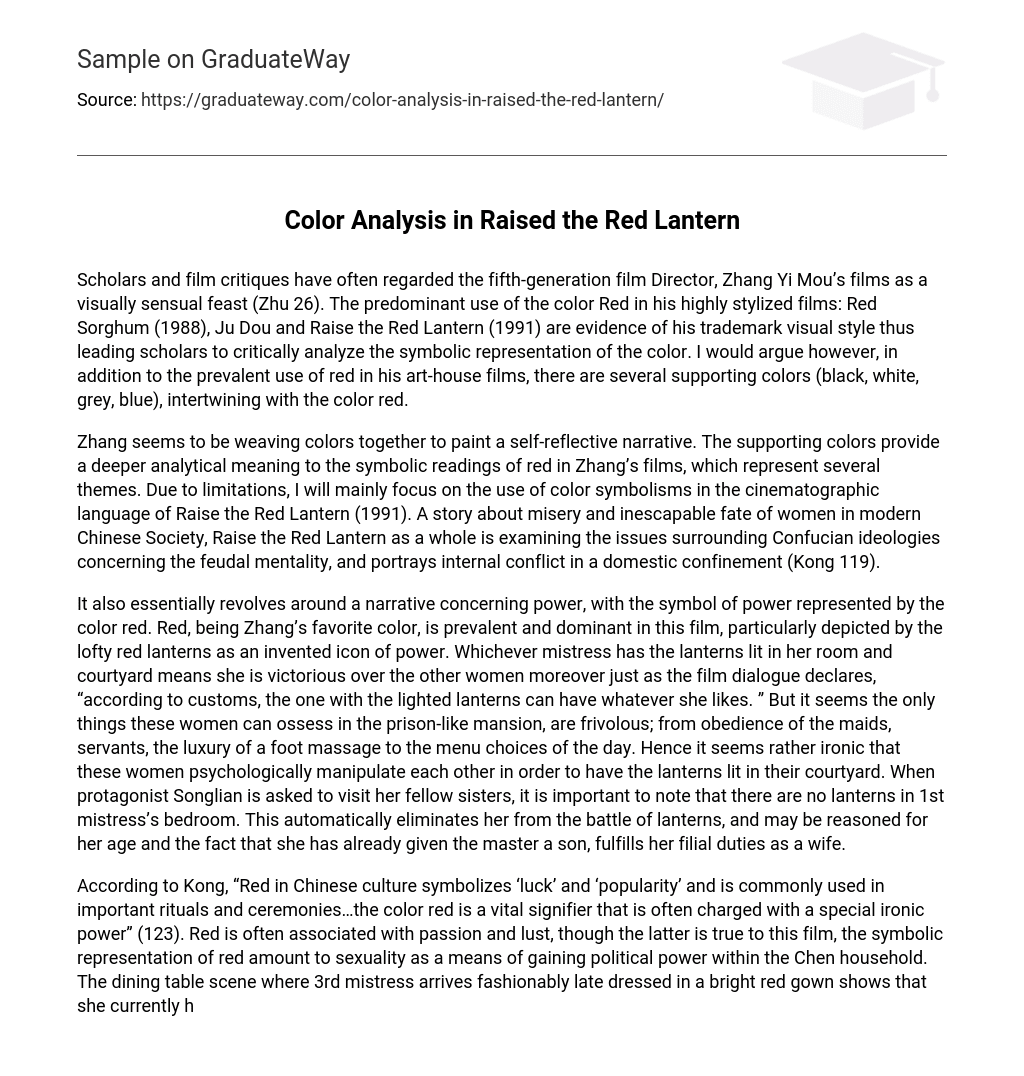Scholars and film critiques have often regarded the fifth-generation film Director, Zhang Yi Mou’s films as a visually sensual feast (Zhu 26). The predominant use of the color Red in his highly stylized films: Red Sorghum (1988), Ju Dou and Raise the Red Lantern (1991) are evidence of his trademark visual style thus leading scholars to critically analyze the symbolic representation of the color. I would argue however, in addition to the prevalent use of red in his art-house films, there are several supporting colors (black, white, grey, blue), intertwining with the color red.
Zhang seems to be weaving colors together to paint a self-reflective narrative. The supporting colors provide a deeper analytical meaning to the symbolic readings of red in Zhang’s films, which represent several themes. Due to limitations, I will mainly focus on the use of color symbolisms in the cinematographic language of Raise the Red Lantern (1991). A story about misery and inescapable fate of women in modern Chinese Society, Raise the Red Lantern as a whole is examining the issues surrounding Confucian ideologies concerning the feudal mentality, and portrays internal conflict in a domestic confinement (Kong 119).
It also essentially revolves around a narrative concerning power, with the symbol of power represented by the color red. Red, being Zhang’s favorite color, is prevalent and dominant in this film, particularly depicted by the lofty red lanterns as an invented icon of power. Whichever mistress has the lanterns lit in her room and courtyard means she is victorious over the other women moreover just as the film dialogue declares, “according to customs, the one with the lighted lanterns can have whatever she likes. ” But it seems the only things these women can ossess in the prison-like mansion, are frivolous; from obedience of the maids, servants, the luxury of a foot massage to the menu choices of the day. Hence it seems rather ironic that these women psychologically manipulate each other in order to have the lanterns lit in their courtyard. When protagonist Songlian is asked to visit her fellow sisters, it is important to note that there are no lanterns in 1st mistress’s bedroom. This automatically eliminates her from the battle of lanterns, and may be reasoned for her age and the fact that she has already given the master a son, fulfills her filial duties as a wife.
According to Kong, “Red in Chinese culture symbolizes ‘luck’ and ‘popularity’ and is commonly used in important rituals and ceremonies…the color red is a vital signifier that is often charged with a special ironic power” (123). Red is often associated with passion and lust, though the latter is true to this film, the symbolic representation of red amount to sexuality as a means of gaining political power within the Chen household. The dining table scene where 3rd mistress arrives fashionably late dressed in a bright red gown shows that she currently holds the power in the amongst the four mistresses.
This power , once acquired comes with the consequence of being objectified under the red light to the master’s male gaze. Hence referring back to Kong who mentions the power these women gain is ironic. Their victory is the attention of the master’s affection for one night. This further emphasizes the lack of power and importance women have under the Confucian ideologies. Perhaps the red tones during master’s visists are the only warmth and affection they feel within the grey drab prison like mansion.
As an audience, we are only exposed to the distorted or masked images of the master, yet we can sense his omnipresent power and control. He is always shown wearing a changshan, or mandarin gown in black which is the king of all colors and represents the color of heaven. The master’s black changshan reinforces his superior position in the Chen household. In addition, the 3rd mistress Meishan is also shown wearing a black qipao or Chinese dress when she deliberately wakes Songlian by singing loudly in the orning, as a way of exterting her power in the household. Although black symbolizes power and control, it also inherently represents evil and death. This is evident in the scene where all the mistresses stand outside their compounds awaiting master’s instruction; maid, Yan’er stands behind Songlian in a black garment foreshadowing her impending fate. Again, reinforcing this, black is the garment the servants wear when a severely ill Yan’er is being carried out to the hospital.
One of the most iconic scenes in this film is the covering of the red lanterns with black cloth as a punishment when the master finds out that Songlian manipulated the rules of the house by tricking him into believing she is pregnant. The battle between the red lantern and the darkness of the master, he is regaining his power by smothering hers. Juxtaposition between balck and red. Just like lighting lanterns is an old custom in the Chen household, foot massages seem to be another fetish in the household. All mistresses are wearing red shoes and Songlian learns of Meishan and Dr. Gao’s affair when she sees





